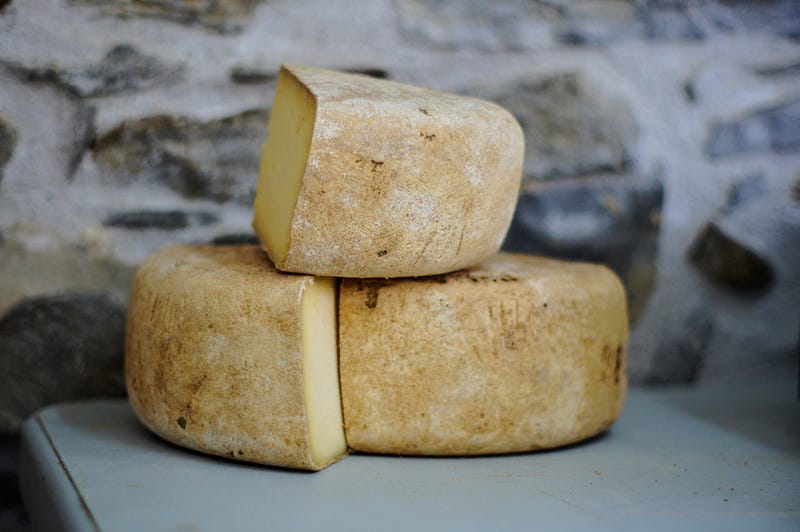The Microbial Warfare Behind Your Cheese: A Deeper Look
Written on
The Battle Within: Understanding Cheese Microbiology
Cheese is not just a delightful addition to our meals; it plays a crucial role in various culinary creations, including some adventurous TikTok food trends. Interestingly, it may even trigger brain reactions similar to those provoked by addictive substances. However, we must acknowledge that cheese, like most foods, isn't exactly sterile.
Bacteria thrive on everything from vegetables to dairy, and while cheese is a haven for these microorganisms, it also serves as a fascinating study of microbial adaptation, particularly in the face of new threats.

The Microbial Battlefield
Cheese is abundant in bacteria, essential for its production. Cheesemakers utilize carefully curated cultures of bacteria, yeast, or fungi to create distinct cheese varieties. This microbial richness makes cheese an ideal subject for studying how bacterial communities evolve when faced with new dangers.
Among these dangers, one of the most formidable is the bacteriophage—a virus that specifically targets bacteria. Just as humans face threats from tiny pathogens, bacteria too are susceptible to disease, primarily from these bacteriophages, which resemble alien craft with their unique structures.

Bacteriophages infiltrate bacteria by injecting their viral DNA, commandeering the bacterial machinery to produce more viruses until the bacterium bursts, releasing these new viruses to find more hosts.
While the odds may seem stacked against bacteria—given the estimated number of bacteriophages on Earth (a staggering 10 nonillion)—they have developed sophisticated defenses. These include molecular weapons that they accumulate over time, similar to how hospitals stockpile antibiotics.
One notable defense mechanism is the CRISPR-Cas9 system. Initially a bacterial tool for cutting DNA, it has been adapted for gene therapy in humans. Bacteria utilize CRISPR to slice the DNA of invading bacteriophages, effectively neutralizing the viral threat before it can replicate.
The Cheese Connection: Sequencing Insights
To better understand the dynamics of bacteria in cheese, researchers sequenced the RNA of bacterial samples. This analysis revealed a wealth of viral resistance genes—17,565 innate immune systems and 1,972 CRISPR-Cas systems—highlighting the bacteria's adaptive strategies.
However, these defensive traits were not uniformly distributed; specific strains exhibited rapid gains and losses of these viral defenses. This suggests a continual adaptation process rather than a stable set of defenses. The bacteria appear to be constantly refining their CRISPR defenses, adapting to an evolving landscape of viral threats.
This insight indicates that rather than being preoccupied with any singular virus, bacteria in cheese are dynamically adjusting their defenses, illustrating the ongoing evolutionary struggle between bacteria and their viral adversaries.
Implications for Cheese Production and Health
While the notion of microbial conflict within our cheese may be unsettling, it's important to recognize that these battles are unlikely to affect human health directly. The viruses and bacteria are primarily engaged with each other, not with us.
This understanding challenges the perception of viral resistance as a static trait. Instead, it reveals a fluid and adaptive landscape where bacteria are perpetually evolving their defenses. This adaptability could also have implications for cheesemakers, particularly in developing strategies to combat harmful bacteria without compromising beneficial ones.
Research into phage therapy offers promising avenues for targeting undesirable bacteria while preserving the microbial communities that contribute to cheese's flavor and texture. In the long run, this approach could extend to improving gut health by selectively eliminating harmful microbes while maintaining a balanced microbiome.
Conclusion: Lessons from Cheese
The microbial world within cheese offers valuable insights that extend beyond culinary enjoyment. It underscores the complexity of microbial interactions and their implications for health and food production.
In the end, cheese remains a delightful treat, regardless of the microscopic battles waged within.
Explore the microbial intricacies of cheese production in this video: "The microbial truth of how your cheese gets made."
Delve into the fascinating world of cheese microbiology with Rachel Dutton in "The Wonderful Microbial World of Cheese KITP Chalk Talk."
Enjoyed the journey through the microbial realm? Share your thoughts on Twitter by tagging @swestreich!